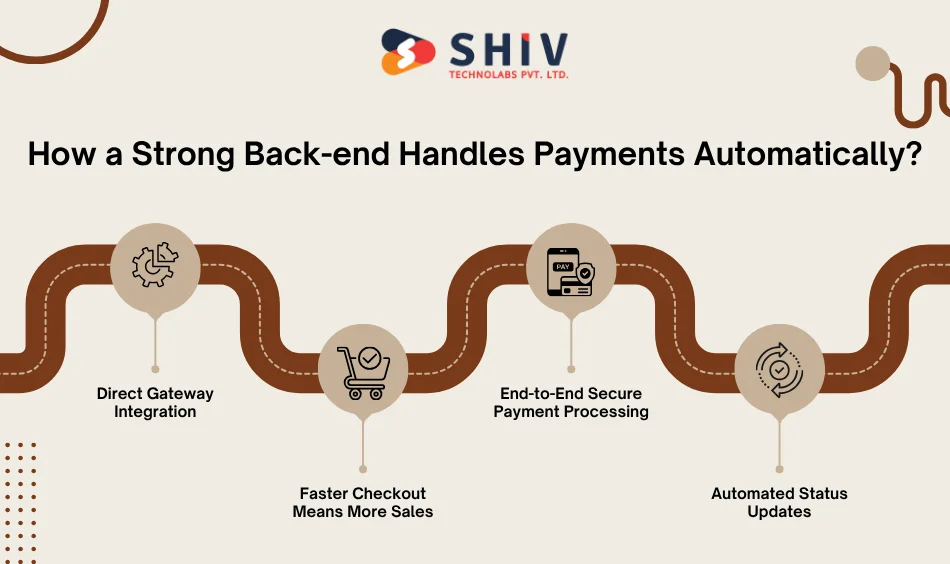Table of Contents
All the attention is paid to design elements such as banner layouts and product images. But customers don’t stop buying because of how a page looks. Most often, they drop off when payments fail, orders do not go through, or when the product shows as available but is actually out of stock.
That’s the job of the backend for an eCommerce website. It determines whether your eCommerce business operates effectively or faces repeated failures.
Report predicts global eCommerce sales will hit $8 trillion by 2028. Each transaction depends on a system that quietly runs behind the screen: the back-end.
That’s why businesses that want to grow do not just focus on front-end appearance. They choose reliable and scalable eCommerce backend systems that are fast, secure, and automated. They often work with backend development companies that understand how to build systems that work under pressure.
What Is an eCommerce Back-End and What Does It Do?
The eCommerce back-end works behind the scenes. Customers never see it, but it handles all the critical parts of their shopping experience.
It does the following tasks:
- Safely handles transactions without exposing sensitive data
- Tracks and updates stock as items sell or return
- Processes and updates orders from cart to delivery
- Connects with CRMs, email tools, and shipping software
If your store runs smoothly, with orders being processed, stocks updated, and payments going through without delay, your back-end is doing its job.
You can think of it as a control room. Every click triggers actions that run in the back-end to keep the store functional, secure, and accurate.
How a Strong Back-end Handles Payments Automatically?

A good backend integration for eCommerce handles payments quickly and without errors. Here is how it works step by step:
1. Direct Gateway Integration
An efficient back-end will integrate with gateways such as Razorpay, Stripe, PayPal, or Authorize.net. Such APIs enable the system to approve or decline payments in real time, as well as to update order systems with their payment information.
2. Faster Checkout Means More Sales
Speed matters. A good back-end makes checkout fast. It avoids page reloads or redirects. The result is more completed orders and fewer abandoned carts.
3. End-to-End Secure Payment Processing
Secure back-ends follow PCI-DSS rules. They encrypt and tokenize card details, ensuring secure payment processing. This builds trust with buyers.
4. Automated Status Updates
Once the payment is successful, the back-end updates the order status. It can also create invoices and pass the details to shipping tools. This is all done automatically without human input.
How Does the Back-End Manage Orders Without Manual Work?
Order management has moved beyond spreadsheets and manual tracking. Now, back-end systems take care of everything after the customer clicks ‘Buy.’
1. Cart-to-Confirmation Flow
After a customer has submitted an order, the back-end will auto-capture all the cart information and issue an Order ID before forwarding the information to the corresponding system. This process is fast and leaves no gaps.
2. Real-Time Order Tracking
The back-end updates dashboards with payment and shipping status. Customers also receive real-time updates, avoiding the need to reach out for help.
3. Instant Email
The system issues delivery alert mails, receipts, and confirmation of delivery. These actions operate on a back-end logic, and the emails behave according to the logic that is defined in your workflow.
4. Shipping Label Generation
Shipping tools like ShipRocket, Shippo, or EasyPost can link directly with the back-end. The system creates shipping labels as soon as the order is ready.
5. Fewer Errors, Fewer Tickets
Because back-end logic handles everything, there’s less chance of human mistakes. This means fewer support issues, returns, and manual corrections.
How an eCommerce Back-End Syncs Inventory in Real Time
Inventory accuracy is critical. If stock numbers are off, customers face delays or cancellations. A strong back end prevents that.
1. Sale = Auto-Update
Every sale updates the stock count immediately. There is no need for manual entry. This is managed by the back-end automatically.
2. No More Overselling
The back-end blocks purchases for items that are out of stock or below the threshold. This avoids refund requests and negative feedback.
3. Multi-Channel Sync
If you sell through multiple platforms like your website, Flipkart, Amazon, or social media, the back-end keeps all listings updated in real time.
4. Low Stock Alerts
Alerts are sent to the warehouse or to the vendors in cases where there is a shortage of stock. This allows timely restocking.
5. Sync With Supply Chain
More advanced setups enable the back-end to give information to suppliers. It automates reorder points and schedules deliveries, ensuring you never run out of stock.
Your Back-end Connects It All: CRM, Shipping, and More
The back-end links different tools and platforms. It works as the central system that shares data across channels.
1. CRM Sync for Smarter Sales
Connecting your back-end to a CRM allows tracking of past orders, buying behavior, and cart abandonment. This data helps in customer targeting.
2. Email and SMS Marketing Tools
Back-end order activity data feeds into software such as Mailchimp or Klaviyo. This will assist you in sending relevant promotions or reminders.
3. Shipping and Logistics Integration
Be it FedEx, Delhivery or some other courier, the back-end will share order information, accept tracking updates and be in sync with your internal logistics team.
4. Warehouse Management
Back-ends talk to warehouse systems to assign picking and packing jobs. It also tracks product movement and verifies order accuracy.
5. Analytics and BI Dashboards
The back-end pushes data to tools. The back-end feeds tools such as Tableau or Power BI. This assists you in making better decisions based on real-time order and sales data.
Tableau or Power BI. This helps you make better decisions using real-time order and sales information.
Why Custom eCommerce Back-ends Give You More Flexibility?

Standard systems come with limits. A custom back-end can provide you with more control and choices in case your business has custom needs.
1. One-Size Doesn’t Fit All
Pre-built platforms often can’t manage features like subscriptions, bulk discounts, or advanced tax setups. Custom logic allows you to include these features with ease.
2. Tailored to Business Goals
A custom back-end is customized to your specific rules and needs. It supports multi-vendor setups, B2B deals, or region-based taxes without restrictions.
3. Easier Scaling
As your store expands, a custom back-end can respond to more logged-in users, increased traffic and greater data, all without slowing you down.
4. Future-Proofing
In case of future additions, such as AI tools or new payment processes, a custom back-end will enable you to add the functionality without having to create it anew.
5. Unique User Experiences
If you want to show special prices to logged-in users or provide account-based discounts, custom backends support these setups without performance issues.
What Can Go Wrong with a Weak Back-end?
If your backend is weak, your entire store may suffer. These are the common signs that show a failing back-end:
1. Slow Checkout and Lost Sales
If pages load slowly during checkout, customers may leave without finishing their purchase. The cause is usually slow back-end responses.
2. Inventory Glitches
Selling out-of-stock items can damage your store’s reputation. This happens when the back-end fails to update stock in time.
3. Failed Orders or Double Charges
Poor back-end coordination leads to issues like duplicate charges, partial orders, or missing confirmations.
4. Frustrated Customers
If customers don’t receive updates or have to wait too long for delivery information, they stop trusting your brand. A weak back-end leads to more customer complaints.
How a Back-End Development Company Helps You Get It Right
A back-end system needs proper planning and execution. That’s where back-end development companies come in.
1. Mapping the Right Architecture
A good back-end company designs the full system layout. They select the right technology, establish a logical flow, and plan for long-term growth.
2. Built Around Your Business
Rather than templates, they develop a back-end tailored to your business model, including pricing, payment flow, and operational structures.
3. Continuous Support and Optimization
They do more than just build systems. They test, update, monitor, and keep your back-end secure and fast.
4. Speed, Security, and Stability
Professional teams reduce downtime and stop back-end errors. This gives you a smooth experience, especially on busy sales days.
5. Future-Ready Integrations
A reliable back-end company prepares your system to accept future tools, channels, or changes without significant rework.
Build Smarter With Shiv Technolabs
Your back-end is not something to ignore. It powers everything that keeps your store running. At Shiv Technolabs, we build custom eCommerce backend systems for modern eCommerce businesses.
If you are starting or scaling up, our eCommerce development solutions can handle your payment, stock, and order processes with full automation.
As a leading backend development company, we offer specialized backend services for Shopify Plus, headless commerce, and custom setups that fit your store perfectly.
Book a free consultation with our experts now.
Conclusion
Your back-end does not appear on your site. But it runs every part of it. Without a strong back-end, payments fail, orders are wrong, and stock becomes unreliable.
If you want a store that scales without constant fixes, stop using patchwork solutions. Build the proper back-end from the beginning.
Shiv Technolabs builds systems that power your growth. With automation, API links, and custom logic, our back-ends help your store run better every day.
If your store is growing fast, your back-end should be ready too. Contact us today and build a back-end that supports your future.



















